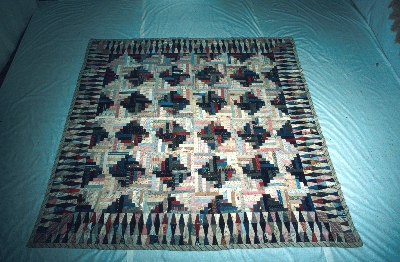Quilt No.298WHF - National Pioneer Women's Hall of Fame
2360 x 2340mm
Made about 1895 in Carlston, near Violetown, North East Victoria, by Nicholes Wallace for her daughter-in-law, Alma Gibbs, who married her son John Brown. It then passed to Mrs Pat Fleming, Nicholes' grand-daughter who donated it to the National Pioneer Women's Hall of Fame, Alice Springs (NT).
Nicholes Wallace was the second wife of Isaac Wallace, who was a farmer in Carlston, near Violet Town (Vic). Isaac was Nicholes' second husband. She had four sons by her first marriage to a Mr Brown, and made quilts for all her daughters-in-law. Nicholes had a daughter, Elizabeth, from her marriage with Isaac. Her son John, married Alma Gibbs in 1902. Nicholes died in 1905.
Pat Fleming, grand-daughter of Nicholes was the last family owner of the quilt.
"In Memorium Pat Fleming 1915-1995.
���.Pat was committed to preserving the heritage of the Alice. A life member of the National Trust of Australia Pat had been a committee memberof the Trust's MacDouall Stuart Branch in Alice Springs since its establishment in 1979 and served as branch secretary, councillor and treasurer before retiring from these posts in 1994. Pat's life story is both fascinating and uplifting, encompassing the true essence of the pioneering spirit in the harsh outback of Australia.
Daisy Alma Wallace (known as Pat) was born on 2 March 1915 at Gowangardie in Victoria. She married the Rev. Tom Fleming, an ordained Baptist minister who, in 1950 was appointed missionary at the Yuendumu Aboriginal settlement.
The move from the south east coast to Central Australia must have involved dramatic changes in Pat's life style.
We read that 'the mail came in every 2 weeks, supplies every 2 months and electricity only after 9 years. The Flemings had to rebuild a white- ant ridden house and started virtually from scratch.
Pat recalls what a challenge it was to make a home and garden in the desert and to educate her own 2 sons in isolation to secondary level, but with hard and rewarding effort she coped - and did much else besides.
There was no school at Yuendumu when the Flemings arrived so Pat voluntarily conducted a pre-school for young Aboriginal children for 8 years while assisting her husband with all aspects of his work as missionary. She visited 3 cattle stations per fortnight to talk with and assist the women with schooling their children.
Pat also managed the local store from 1965 onward. This evolved into a supermarket and with Pat as assistant Manager had an annual turnover of $175.000 by the time of her departure in 1975.'
Following the Fleming's retirement to Alice Springs they became involved in church activities and the National Trust. Unfortunately Pat was never to publish the book based on her diaries kept since her arrival in Central Australia."
[Source: Pioneer Women, a publication of the National Pioneer Women's Hall of Fame Inc. December 1995. Vol 2 No.4]
Related Quilts:
1400 x 1150mm
2010 x 1910mm
2160 x 1830mm
2430 x 2250mm
2540 x 2370mm
2210 x 1850mm








